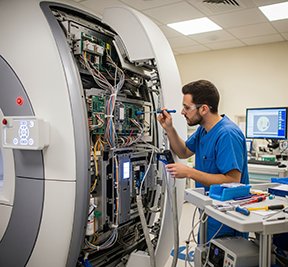Published: October 13, 2025 | Updated: October 10, 2025
Published: October 13, 2025 | Updated: October 10, 2025
The Crucial Role of Annual Maintenance Contracts in Modern Asset Management
 Let's look at the crucial role of Annual Maintenance Contracts, often called an AMC, in modern asset management. This formalized agreement between a business and a service provider outlines a schedule of proactive upkeep, ensuring equipment operates reliably. The integration of a Computerized Maintenance Management System (CMMS) takes this foundational practice and elevates its impact, moving beyond simple scheduling to create a dynamic, data-driven approach to maintenance.
Let's look at the crucial role of Annual Maintenance Contracts, often called an AMC, in modern asset management. This formalized agreement between a business and a service provider outlines a schedule of proactive upkeep, ensuring equipment operates reliably. The integration of a Computerized Maintenance Management System (CMMS) takes this foundational practice and elevates its impact, moving beyond simple scheduling to create a dynamic, data-driven approach to maintenance.
What Is an Annual Maintenance Contract (AMC) and Why It Matters
An AMC is a service agreement that provides regular maintenance and support for specific equipment or assets over a defined period, typically one year. It keeps assets in good working order through planned, recurring service. A standard AMC might include regular maintenance visits, parts, and labor, alongside other valuable services like software updates or system calibrations. This contract is a proactive measure, a commitment to preventive care that keeps an asset performing its intended function without interruption.
Within the framework of an AMC, a company establishes a predictable maintenance cycle. For example, a manufacturer’s contract for a CNC machine might schedule quarterly inspections, including lubrication, parts replacement, and performance diagnostics.
A hospital's AMC for a critical care ventilator involves monthly checks and software updates. These contracts remove the uncertainty of reactive, break-fix repairs, making it possible to budget for maintenance with greater accuracy.
A CMMS provides the digital repository for these agreements. It holds a centralized record of every AMC, including contract numbers, service provider details, renewal dates, and the specific equipment covered. The system automatically tags assets under contract, giving managers a clear view of their maintenance landscape. Instead of a technician sifting through paper files or spreadsheets, a CMMS instantly pulls up the relevant contract details when a work order is generated, confirming what services a provider should perform and what parts the contract covers. This central repository ensures no contract slips through the cracks.
Why Annual Maintenance Contracts Are a Strategic Investment
An AMC offers strategic benefits that extend far beyond simply keeping a machine running. These agreements give a business a significant advantage in risk mitigation and financial planning. By having a pre-determined maintenance schedule, companies drastically reduce the risk of a catastrophic equipment failure, which can halt production and create massive financial losses. The reliability an AMC offers translates directly into greater operational uptime.
Consider a large data center. Its cooling systems, servers, and power generators are all under strict AMCs. A failure in any of these components could take the entire facility offline, resulting in millions of dollars in losses. The contracts provide peace of mind and a guarantee that a qualified technician will address any issues promptly.
A CMMS gives managers the tools to measure this reliability. By logging all AMC-related work orders and the associated downtime, the system provides crucial data on asset performance. A dashboard might show an asset's uptime percentage, highlighting the tangible return on investment from the AMC. This type of approach moves maintenance from a cost center to a strategic investment that directly impacts a company’s bottom line.
Discover how streamlined maintenance processes can elevate production. Learn more.
Using CMMS Software to Maximize the Value of AMCs
A CMMS transforms the management of AMCs from a manual, administrative task into a dynamic, automated process. It acts as a powerful ally, ensuring that every term of the contract is met and that every maintenance action is recorded with precision.
Automated Scheduling and Work Order Generation
The most immediate benefit of a CMMS for AMC management is its ability to automate the entire work order process. Managers input the AMC's schedule into the system—quarterly visits, annual inspections, or monthly calibrations. The CMMS then allows the conversion of a PM procedure into a work order for each event on the specified date. This eliminates the possibility of a missed service appointment. The system can automatically notify the service provider and the internal team, dispatching the work order to the right people at the right time.
For a commercial real estate company managing a portfolio of buildings, a CMMS could house AMCs for every HVAC system, elevator, and fire safety setup. Instead of a facility manager tracking hundreds of individual contracts on a calendar, the CMMS issues a work order for the elevator inspection in Building A on the third Tuesday of the month. The system assigns the task to the third-party service provider and sends a notification to the building manager. This automation guarantees compliance and frees up personnel for other duties.
Centralized Record-Keeping and Reporting
A CMMS creates a single, accessible source of truth for all maintenance data. Every service report, every part replaced, and every technician’s note from an AMC visit is logged directly into the system. This comprehensive history is invaluable for several reasons. It provides a detailed audit trail for compliance with industry regulations, and it provides a full picture of an asset’s health.
In a pharmaceutical manufacturing plant, a CMMS holds the AMC for a specialized mixing vessel. A technician from the service company performs a planned service, and their report and list of replaced parts go directly into the CMMS under that vessel’s asset profile. If an auditor comes to review the equipment's history, the company presents a complete, unassailable digital record. This approach removes the need for physical paperwork and reduces the risk of lost or inaccurate information.
Performance Tracking and Vendor Management
An AMC is only as good as the service provider fulfilling it. A CMMS gives a company the ability to monitor and evaluate vendor performance against the contract’s Service Level Agreements (SLAs). The system tracks key metrics like response time, repair duration, and the first-time fix rate. This data allows a business to hold its partners accountable.
Imagine a food processing facility with an AMC on its conveyor systems. The contract guarantees a four-hour response time for emergency repairs. The CMMS tracks every time a technician responds to a call. A dashboard displays which vendors consistently meet or miss their SLAs, providing objective data for contract negotiations or selecting a new provider. This capability ensures a company gets the value it pays for.
AMC and CMMS Applications Across Key Industries
The practical application of an AMC varies significantly across industries, each with its own unique challenges and assets.
Healthcare Facilities
 Hospitals rely on highly specialized, life-critical equipment. An AMC on a magnetic resonance imaging (MRI) machine, for example, is not a luxury; it is a necessity for patient safety and operational integrity. These contracts often include strict response times and require certified technicians with specific training.
Hospitals rely on highly specialized, life-critical equipment. An AMC on a magnetic resonance imaging (MRI) machine, for example, is not a luxury; it is a necessity for patient safety and operational integrity. These contracts often include strict response times and require certified technicians with specific training.
The CMMS in a healthcare setting is crucial for ensuring regulatory compliance. The system automatically archives every maintenance action, calibration, and software update performed on the machine, creating a perfect record for audits from organizations like the FDA. The CMMS also flags upcoming service dates and links the work order directly to the asset, its location, and the specific AMC, making sure the right provider services the machine on time.
Manufacturing Sector
In a manufacturing environment, a robotic welding arm performs repetitive tasks at high speeds. An AMC for this piece of equipment focuses on preventive maintenance and precision calibration. The contract might include monthly checks, sensor adjustments, and a full recalibration every six months. The CMMS integrates with the welding arm’s sensors, collecting data on its usage and performance. When the CMMS detects an issue or an upcoming maintenance event, it creates a work order and notifies the vendor. By cross-referencing AMC schedules with production calendars, the CMMS helps schedule maintenance during planned downtime, preventing disruptions to the manufacturing process.
Commercial Real Estate
For a commercial property manager, an AMC covers a wide range of assets, from heating and cooling systems to fire suppression and security cameras. The CMMS for this operation provides a bird’s-eye view of all contracts across multiple buildings. The system tracks the condition of each asset, its maintenance history, and its location. A manager can view a dashboard that shows the status of every AMC—which ones are approaching renewal, which assets are due for service, and which vendors are performing well. This data allows the manager to make informed decisions and maintain a safe, comfortable, and compliant environment for tenants.
The Evolving Future of Annual Maintenance Contracts with CMMS
Annual Maintenance Contracts are shifting in focus, driven by the capabilities of a modern CMMS. We move from a purely reactive mindset to a predictive one. The future of AMCs involves contracts that incorporate data from sensors and IoT devices. A CMMS like MAPCON will use this real-time data to help supervisors forecast when an asset might fail. This can help shape the preventive maintenance program. This approach offers a new level of efficiency and asset protection. Maintenance agreements will evolve into a data-informed model, where the terms and service levels are a direct result of an asset's actual usage and condition, not just a pre-set calendar. This forward-looking strategy keeps businesses ahead of potential failures and helps ensure long-term operational success.
FAQs
What is the main purpose of an Annual Maintenance Contract (AMC)?
An AMC ensures that your equipment or systems receive regular preventive maintenance to reduce downtime and extend asset life.
How does a CMMS improve AMC management?
A CMMS automates scheduling, tracking, and reporting of maintenance activities, ensuring no service is missed and all data is recorded efficiently.
What industries benefit most from AMCs?
Industries like manufacturing, healthcare, and commercial real estate gain the most from AMCs due to their need for reliable and continuous equipment performance.
Can a CMMS like MAPCON help track vendor performance?
Yes, MAPCON’s CMMS allows businesses to monitor vendor response times, repair efficiency, and overall service quality for better contract management.
How often should AMCs be renewed?
Most AMCs are renewed annually, though some businesses may choose multi-year contracts for long-term cost stability and service continuity.
What’s the difference between preventive maintenance and an AMC?
Preventive maintenance focuses on routine checks, while an AMC is a formal agreement that includes service commitments, parts, and labor over a set period.
MAPCON | 800-922-4336
MAPCON CMMS software empowers you to plan and execute PM tasks flawlessly, thanks to its wealth of features and customizable options. Want to see it for yourself? Click the button below to get your FREE 30-day trial of MAPCON!
Try It FREE!